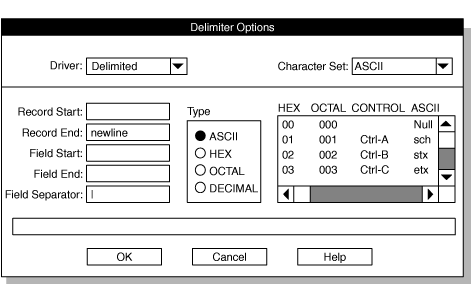Modifying delimited-format options
About this task
- Character set
- The code set used to translate the data in the data table.
- Driver
- The driver that is used with the delimited format. For more information, see Selecting a driver.
- Delimiting characters
- The delimiting characters, which are sometimes called record separators
and field separators, indicate the beginning and end of records and
fields.
You can specify the delimiting characters in ASCII, HEX, OCTAL, or DECIMAL format.
You can select the GLS code set you want from the Character Set selection list. For information about locales and code sets, see the Informix® GLS User's Guide.
To modify the options for delimited formats:
Procedure
-
Display the Delimited Format Definition window.
To display the window, complete the steps in Creating a fixed format with the following modification: in step 3, click Delimited.
-
Click the Options button in the Delimited
Format Definition window.
The Delimiter Options window appears, as the following figure shows.
Figure 1. The Delimiter Options window 
-
Modify the options that you want to change, or
add information.
For example, add Field Start and Field End information to mark the beginning and end of a field (column).
The default escape character is \ (the backslash).
If the Field Start and Field End values contain both single or double quotation marks and specified characters are not present in a field, an error occurs. The error occurs because the input does not match the expected layout. If one of these characters appears in a field, you must mark the character with the escape key (to escape the character).
For comma-separated values (CSV), enter , (a comma) in the Field Separator field. For more information, see Testing the import of a CSV file.
An error can also occur if the Field Separator value appears inside a quoted field or any special character (such as the end field, end record, or escape character) appears in a field. In this case, you must also escape the character.
- Click OK to save your changes and return to the Delimited Format Definition window.
Results
For more information about environment variables, see the Informix® Guide to SQL: Reference.